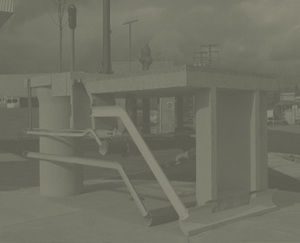Trevor Boddy
Canadian Art, Winter 2004, Vol. 21, No. 4, p. 93.
The new National Works Yard complex is the hub for city-works crews that keep Vancouver's potholes filled, traffic lights running, sewers unplugged and parking meters emptied. There is a major commissioned sculpture at each end of the $23-million complex, though similarities between the two works end there.
The University of British Columbia fine arts professor Richard Prince was given a brightly painted late-1940's Buffalo Springfield steamroller to work with. The artist had silhouettes of workers cut out of steel plate, then placed them to perch on and around the over-restored antique paver like so many New Deal cipher-citizens. The cloyingly safe sentimentality that consequently radiates from Road Roller is the disease of recent public art in Vancouver, and in many other places.
At the opposite end of the site, the Simon Fraser University art professor Greg Snider has done something entirely more interesting. While Prince's schematic steel cut-outs celebrate civic labourers, Snider instead celebrates their labour-the pipes and gaskets and drains that their skills and invention shape every workday. Visiting his stacked and ordered array of natural-gas lines, sewer pipes, water mains, parking meters and traffic lights at the corner of National Avenue and Chess Street, Snider offers a bit of biography that is already self-evident: "I have always been a sidewalk superintendent."
Snider's sculpture—Project for a Public Works Yard—is both heroically scaled and frankly didactic, possessing the same relationship to the arts of municipal engineering that Renaissance equestrian statues have to the arts of war. Snider makes no apologies about the didacticism of the artwork, which, he points out, draws heavily on the cutaway perspective conventions of technical drawing. As he explains, "I could have taken these pieces of civic infrastructure and composed them in a Constructivist fashion, but that would have reduced the pleasure of knowing how they fit together into systems, and how they are actually crafted by civic workers.
Snider collaborated with dozens of civic tradesmen and engineers in avariety of shops to assemble the pieces, then had to learn the functions andmaterial qualities of each by disassembling, preparing and reassemblingthem with custom mounts for the finished work. In rendering the collection structurally stable, vandal-proof and visually engaging from all angles, Project for a Public Works Yard is a tour de force of mechanical and material craft. Snider is proud to acknowledge that he could not have completed the ten-metre-high sculpture on a $91,500 budget without both his civic collaborators and the donations of contractors. The largely 19th-century civic technology on show is by any measure heroic, having done more to improvethe health and happiness of city dwellers than all of contemporary medicine-just ask a Bangladeshi waiting out a flood on a rooftop, or a Brazilian favelista sick from infected water.
Snider is right to describe his work as a "second regard" sculpture: "I started to think of it as the irruption of something subterranean." Like some Borgesian one-to-one-scale map of the world, Project for a Public Works Yard starts on a note of banality, but sparkles in revealing the details of an immanent world.





All Rights Reserved. contact: greg@gregsnider.ca
Project for a Public Works YardNational Street, Vancouver, BC, May 1, 2004
gregsnider.ca Copyright © 2007 - Greg Snider.